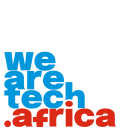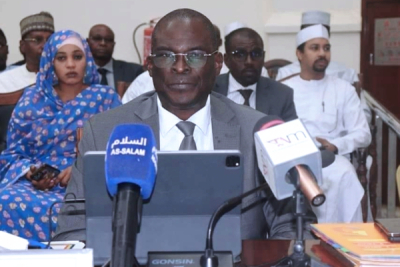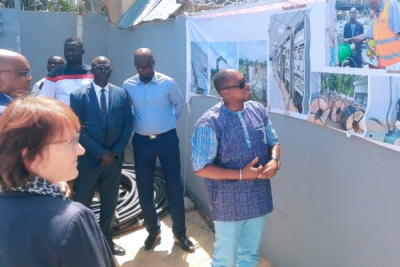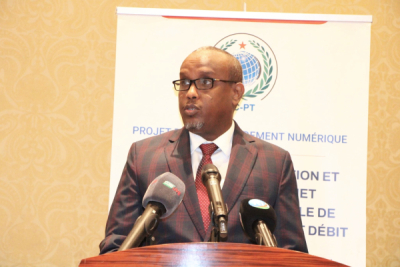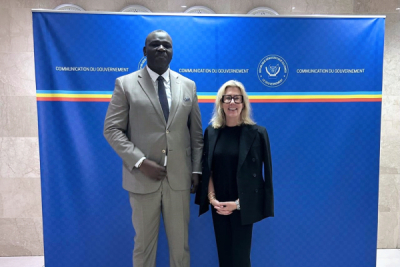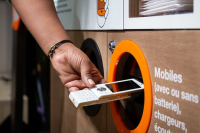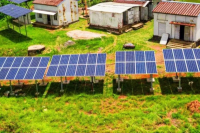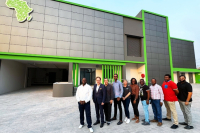
Telecom (150)
In a context where access to technology remains uneven, countries are seeking innovative solutions to improve connectivity. International partnerships, particularly in satellite technology, are essential levers to bridge this digital divide.
The Democratic Republic of Congo (DRC), on Tuesday, November 12, signed a memorandum of understanding with Monaco's leading satellite operator, Monacosat, to expand satellite infrastructure in the country. The agreement, signed by Congolese Minister of Posts, Telecommunications, and Digital Economy Augustin Kibassa Maliba (photo, left), aims to bridge the digital divide in rural and remote areas.
The partnership will involve discussions to finalize the details of deploying a satellite telecommunications network in the DRC, leveraging Monacosat's satellite capacity. According to a statement from the Congolese Ministry of ICT, the initiative aims to bridge the digital divide in rural and hard-to-reach areas by leveraging Monacosat’s satellite capabilities to expand connectivity. “We have decided to work closely together and consult on matters of mutual interest, focusing on the deployment of a satellite telecommunications network in the DRC through the acquisition of satellite capacity from Monacosat,” the statement read.
This initiative aligns with DRC's “Horizon 2025” National Digital Plan, which seeks to develop a robust digital infrastructure to connect the country. It follows a recent cooperation agreement signed with the Polish government to support digital infrastructure expansion in the DRC.
Despite government efforts, the country continues to show low connectivity rates. According to the Congo Post and Telecommunications Regulatory Authority (ARPTC), as of June 30, 2023, only 30.79% of Congolese had access to mobile internet, and a mere 0.0174% had fixed internet access. The United Nations' latest "E-Government Survey 2024," published in September, highlighted this gap, noting that the DRC’s telecom infrastructure development index stands at 0.1591, well below the African average of 0.4534.
If negotiations succeed, Monacosat would extend its coverage across the DRC using its TurkmenAlem52E/MonacoSAT satellite, which already operates in Africa. This initiative could not only connect millions of Congolese but also facilitate access to education, healthcare, and digital public services, contributing to the country’s overall development. It could also help offset delays in the fiber optic network expansion, which is estimated to require nearly 50,000 kilometers of additional coverage.
Samira Njoya
Mobile internet access in Africa is evolving rapidly, yet speed disparities persist. While some countries report strong connection speeds, others struggle to keep up due to infrastructure and technological challenges.
South Africa leads the African continent in terms of mobile download speeds, averaging 34.5 Mbps, according to a report published, on Monday, by mobile data analytics firm Opensignal. This speed is 50% faster than that of Zimbabwe, which ranks second, and four times faster than Angola, which is at the bottom of the list.
Titled The State of Mobile Network Experience in Africa, the report covers 27 African countries and attributes these disparities to differences in network infrastructure investments and spectrum management. In South Africa, sustained efforts to modernize infrastructure and the rapid adoption of 4G and 5G technologies have enabled faster, more reliable connectivity. Conversely, Angola remains reliant on older technologies like 2G, which limit speeds and hinder the use of modern applications—a challenge also affecting countries like Zimbabwe and Mali, where infrastructure still needs significant upgrades.
In terms of Consistent Quality (CQ), a measure of the stability needed for services like video calls, South Africa and Tunisia perform well, with CQ scores of 58.6% and 57.6%, respectively. However, in over half of the African countries analyzed, CQ scores fall below 30%, indicating unstable connectivity that limits user experience, especially in countries like Mali, Guinea, and Cameroon.
To address these gaps, Opensignal suggests governments should invest in infrastructure, ensure efficient spectrum allocation, create supportive regulatory frameworks, enhance digital skills, address device affordability, and promote wider adoption of 4G and 5G technologies.
According to the GSMA increased mobile internet use could add about $795 billion to Africa’s GDP between 2023 and 2030. This underscores the significant economic impact that enhanced connectivity could have across the continent.
Samira Njoya
Chadian citizens frequently complain about poor telecom services, particularly internet quality. The latest major outage occurred on October 15 and lasted about 24 hours.
Boukar Michel (photo), Chad’s Minister of Communications, Digital Economy, and Digitalization of Administration, has announced a series of projects aimed at modernizing the national telecom network and reducing consumer costs. He addressed the National Transitional Council on November 5, following the adoption of a law amending Article 13 of the Regulatory Authority for Electronic Communications and Postal Services (ARCEP).
A New Mobile Operator to Enter the Market
One of the key initiatives includes the upcoming launch of Salam, a subsidiary of the state-owned operator Sotel, which will end the current duopoly of Airtel and Moov Africa. In Q3 2024, Moov Africa Chad, a subsidiary of Maroc Telecom Group, reported 6.7 million subscribers and held a 55% market share as of September 2023, making it the market leader.
The entry of Salam is expected to increase competition, ultimately benefiting Chadian consumers seeking better quality services at more affordable prices.
Additionally, the government aims to sell 60% of its stake in Sotel to a private investor to bring in the technical and financial resources needed to revitalize the operator and make it more competitive against Airtel and Moov Africa. Sotel’s fixed and mobile subscriber base has declined over the past seven years, reaching only 23,907 in 2020, according to ARCEP.
Improved Telecom Infrastructure
Michel also announced plans to deploy 200 telecom sites with 3G and 4G capabilities to improve nationwide coverage. According to the International Telecommunication Union's (ITU) DataHub, 3G and 4G networks covered 68% and 36% of the population in 2022, respectively. While 2G coverage reached 86.8%, 5G is yet to be deployed in Chad.
This infrastructure upgrade aims to improve service quality amidst a recent decline in telecom availability. The latest significant outage on October 15 lasted approximately 24 hours, and just ten days later, Airtel Chad experienced a service disruption affecting voice, SMS, and internet for several hours.
These infrastructure investments align with the government’s strategy to strengthen the digital network, particularly through the Trans-Saharan Fiber Optic Backbone project. This initiative will connect Chad with neighboring countries, providing indirect access to undersea cables via coastal nations such as Nigeria, Benin, and Algeria, each linked to multiple undersea cables. The project is expected to be completed by late 2024 or early 2025.
These expanded capacities should enhance internet quality in Chad, a landlocked nation currently reliant on Cameroon and Sudan for its international connectivity.
Starlink
The minister also revealed ongoing discussions with satellite internet provider Starlink. The government anticipates that SpaceX’s Starlink subsidiary will help drive down internet costs.
Starlink plans to begin commercial operations in Chad in 2025, pending regulatory approvals. Pricing details for Chad are not yet available. However, in Benin, where Starlink launched in November 2023, the monthly subscription costs 30,000 CFA francs (around $50), with a one-time terminal cost of 400,000 CFA francs.
Isaac K. Kassouwi
As a landlocked country, Chad is focusing on interconnections with coastal neighbors that have direct access to submarine cables. These connections are currently limited, as the country is only linked to Cameroon and Sudan.
In Chad, the European Union (EU) and the African Development Bank (AfDB), partners in the Trans-Saharan Fiber Optic Backbone project, have expressed overall satisfaction with the progress of the work. On Thursday, October 24, a delegation from both institutions accompanied Boukar Michel, Chad’s Minister of Telecommunications and Digital Economy, on a site visit in N'Djamena.
According to Brahim Abdelkerim, Secretary General of the Ministry, approximately 100 kilometers remain to be installed to complete Chad’s section of the backbone. The project includes a 559-kilometer stretch to the Niger border and a 50-kilometer metropolitan network in the capital. The completion is expected by the end of the year or early 2025.
This positive assessment comes around six months after Boukar Michel’s previous visit, during which he criticized the slow pace of work and hinted at potential “drastic measures.” In May 2023, the government revived the project, initially launched in 2020. The consortium CGPS/LORYNE, responsible for the execution, was originally scheduled to complete the work within ten months. The project, costing 20.5 billion CFA francs (approximately 33.9 million USD), is financed by the EU and the AfDB, with the Chadian government contributing 1.6 billion CFA francs.
This infrastructure is critical for strengthening Chad’s national telecom network. The landlocked country currently relies mainly on Cameroon and Sudan for international internet capacity, and disruptions in these countries’ fiber optic transport networks often cause significant telecommunications issues in Chad, particularly for internet access.
According to N'Kodia Claude, a representative from the AfDB, Chad will gain access to submarine landing points via Niger, facilitating its connection to international cables. Niger shares borders with coastal countries like Benin, Nigeria, and Algeria, each of which has access to at least three submarine cables. This interconnection is expected to improve the quality of Chad’s internet network while enhancing its redundancy.
Isaac K. Kassouwi
The Djiboutian government has outlined a clear vision: to drive the country toward digital emergence by 2035. A cornerstone of this transformation is the expansion of high-speed internet infrastructure, which the government sees as a vital catalyst for achieving this ambitious goal.
On Wednesday, October 16, Djibouti took a significant step toward digital transformation with the launch of its national broadband development strategy. The official presentation was held during a workshop organized by the Ministry of Communication, in charge of Posts and Telecommunications. This ambitious plan aims to accelerate the expansion of fiber-optic coverage and democratize access to high-speed internet, both fixed and mobile, across the entire country.
According to the Minister of Communication, responsible for Posts and Telecommunications, Radwan Abdillahi Bahdon (photo), the new strategy advocates for lower tariffs and doubling internet speeds without increasing costs. It also focuses on regulatory frameworks, promoting computer literacy, and developing infrastructure, among other priorities.
The initiative is part of the “Djibouti Digital Foundation” project. Supported by the World Bank, this project aims to transform Djibouti into a tech hub by 2035 by promoting digital services and creating a favorable environment for private sector investments in ICT.
Early results of this strategy include the deployment of 250 km of fiber-optic cable in the northern part of the country and the connection of over 100 administrative buildings to high-speed networks. These efforts have helped bridge the digital divide between regions and modernize public services.
With this new strategy, Djibouti aims to address its internet challenges. The country is currently connected to nine submarine fiber-optic cables. Despite these multiple connections, the World Bank has raised concerns about the high cost and poor quality of internet service. In its 2023 diagnostic report on Djibouti's digital economy, the international institution highlighted that the price of high-speed internet in Djibouti is among the highest in the Middle East and North Africa (MENA) region.
In the DRC, the telecommunication sector is undergoing significant modernization. To ensure its overall development, the country can rely on strategic partners such as the World Bank, which plays a key role in supporting this transformation.
The International Finance Corporation (IFC) will support the telecommunication sector in the Democratic Republic of Congo (DRC). The decision was announced during a meeting on Tuesday, September 8, between the Minister of Posts, Telecommunications, and Digitalization, Augustin Kibassa Maliba (photo, left), and Mary Porter Peschka (photo, right), IFC’s Regional Director for East Africa.
“We discussed the willingness [of] the International Finance Corporation to support the Congolese government in the development of the telecommunications sector. The telecommunications sector is of paramount importance, both for the DRC and for our group,” said Mary Porter Peschka.
This initiative is part of the DRC's National Digital Plan (Horizon 2025) which makes telecommunications a key sector. The country is already seeing positive effects from this momentum, with mobile phone subscribers increasing by 6.4 million, from 49.8 million in 2022 to 56.2 million in December 2023, according to the Congolese Postal and Telecommunications Regulatory Authority. Meanwhile, mobile market revenues in the DRC reached 11.898 billion CFA francs ($19.9 million) in July 2023, a 9.7% increase compared to the previous year.
The IFC’s support in the DRC will focus on several strategic areas, including strengthening digital skills and developing and modernizing digital infrastructure, among others. The overarching goal is to create a favorable environment for innovation and investment by attracting new private sector players while boosting the competitiveness of local businesses.
Samira Njoya
With a score of 24.4 on the ICT adoption index of the International Telecommunication Union, Burundi seeks solutions to keep pace with the ongoing digital transformation across the continent. It has turned to Zambia for assistance regarding Internet access.
Burundi and Zambia are set to connect via a fiber optic submarine cable. A memorandum of understanding was signed on the sidelines of the Digital Government Africa summit, held in early October in Lusaka, Zambia. The infrastructure will link the Mpulungu district in Zambia’s Northern Province to Makamba Province in southern Burundi, crossing Lake Tanganyika.
This initiative aligns with both countries’ aim to improve Internet quality. Since 2021, Zambia has invested $58 million in digital infrastructure, which has led to a modest increase in Internet penetration—from 29.4% in January 2021 to 31.2% in January 2024, according to DataReportal. Zambian authorities plan to continue investing to meet the goals outlined in the "National Digital Transformation Strategy 2023–2027."
DataReportal figures show that Internet penetration in Burundi was 10.2% in early 2023. Last September, Burundian authorities launched a project to bridge the digital divide by 2028. Called the Digital Economy Foundations Support Project (PAFEN), it is financed by a $92 million grant from the World Bank.
Moreover, Burundi's connection to Zambia will enable it to join a network of countries already interconnected via fiber optic cables, including Angola, Botswana, the Democratic Republic of Congo, Malawi, Mozambique, Namibia, Tanzania, and Zimbabwe.
Adoni Conrad Quenum
The global telecom sector is currently exploring various initiatives aimed at ensuring the profitability of investments while protecting the environment. However, achieving this balance requires several prerequisites, including recycling plants.
French telecom group Orange recently announced that it collected 479,853 units of mobile phone waste in 2023 across the Middle East and Africa, representing 24% of the devices sold in the region. This initiative is part of the company’s broader strategy to promote a circular economy tailored to the specific needs of each market.
By 2025, Orange aims to increase the use of refurbished equipment in its networks and data centers, supported by its OSCAR program. This program encourages the reuse of devices to reduce carbon emissions and promote sustainable electronic waste management. The company expects this approach to positively impact its equipment expenses.
Since 2010, it has partnered with Emmaüs International and Ateliers du Bocage to establish mobile waste collection workshops in Africa. In 2023, these workshops in Burkina Faso, Cameroon, and Côte d'Ivoire recovered the equivalent of 264,000 mobile devices for recycling.
Last year, the company expanded its recycling efforts in Egypt by partnering with the United Nations Industrial Development Organization (UNIDO) to open a state-of-the-art facility for refurbishing electronic devices. This project supports Orange’s goal of reducing its environmental impact, promotes local job creation, and develops specialized skills.
Additionally, the facility will help promote digital inclusion by offering refurbished phones at more affordable prices to low-income populations. According to a market analysis by Custom Market Insights, the market for refurbished and used mobile phones in the Middle East and Africa was valued at $5.33 billion in 2021 and is expected to reach nearly $12.39 billion by 2030, driven by growing demand for mobile internet.
Muriel EDJO
Committed to a greener future, Orange has set ambitious goals to reduce its environmental and climate impact across its 17 markets in Africa and the Middle East. Various initiatives are underway to achieve these objectives.
Orange Middle East and Africa (OMEA) has converted 10,000 telecom sites and about 20 data centers to solar energy, the company said on Friday, as part of its strategy to bolster infrastructure resilience and maintain profitability.
For Jean-Michel Canto, Chief Climate Officer of OMEA, "Solarization is now a standard configuration for new sites, with an 11% increase in the number of solar sites each year."
In Liberia, where the electrification rate is 12%, the company has solarized 77% of its sites. Jabateh Dweh Charles, Power Manager Operations at Orange Liberia, said this reduced their carbon footprint and fuel consumption by 25% in 2023 compared to 2022.
OMEA's 2023 Corporate Social Responsibility report showed a more than 70% increase in renewable energy use compared to 2022, bringing the share to 32.8% of total energy consumption.
The company prioritizes site solarization and collaborates with energy partners (ESCO – Energy Service Company). In 2022, Alioune Ndiaye, Chairman of OMEA's Board of Directors, noted that solar energy supply saves up to 55 million liters of fuel annually.
These investments align with OMEA's "Lead the Future" and "Net Zero Carbon" by 2040 plans. The company aims to reduce greenhouse gas emissions by 30% by 2025 and 45% by 2030.
Dorothée Vignalou, Chief Financial Officer of OMEA, said, "We have always placed environmental and energy issues at the heart of our regional strategy. Recent crises have strengthened our determination to ensure sustainable management while addressing local community challenges."
The growing demand for connectivity, data storage, and processing in Africa highlights the rapid acceleration of digital transformation across the continent. To meet the needs of businesses and governments, significant investments in digital infrastructure are underway.
Open Access Data Centres (OADC), a subsidiary of digital infrastructure provider WIOCC, launched its first facility in the Democratic Republic of Congo (DRC) on Wednesday in partnership with local company Texaf.
OADC Texaf Digital - Kinshasa is a Tier 3 open-access data center, neutral with respect to operators. It features 2 MW of computing capacity and 1,500 square meters of white space, accommodating over 550 racks.
"OADC Texaf Digital - Kinshasa is central to boosting many sectors of the DRC’s economy, creating rich and vibrant digital ecosystems, and providing content distribution networks and cloud content providers with access to a quality peering location in the country," said Mohammed Bouhelal, Managing Director of OADC Texaf DRC, said,
WIOCC and Texaf signed a shareholder agreement to build the data center in Kinshasa in July 2023. This aligns with WIOCC's plan to expand its digital infrastructure across Africa. The company operates six core data centers across the continent and more than 30 edge data centers in South Africa. It also boasts 200,000 kilometers of submarine fiber systems and 75,000 kilometers of terrestrial fiber. In June, WIOCC secured $41 million in funding to support its investments.
The new facility strengthens DRC’s digital infrastructure, meeting current and future needs of Internet exchange points, content providers, cloud operators, data carriers, telecommunications operators, and Internet service providers in the DRC. The launch comes amid high demand for digital services and high-speed connectivity from individuals, businesses, and government agencies.
Isaac K. Kassouwi
More...
The telecommunications sector is thriving in Gabon, which aspires to become a hub for ICT. The country is supported by partners whose assistance is crucial for achieving its ambitions.
On Wednesday, July 24, Gabon’s postal operator La Poste SA, and the Equatoguinean company Inverfin signed a memorandum of understanding to expand internet access in the tri-border area, which lies at the crossroads of Gabon, Equatorial Guinea, and Cameroon.
Backed by the gabonese ministry of communications, the partnership is the culmination of discussions that began last May during an Inverfin visit to Libreville. Inverfin proposed to fully fund La Poste SA's digital projects in the tri-border area. They also expressed interest in supporting the Economic Interest Group (GIE) Poste Télédiffusion Services Universels, established in February, in its efforts to expand telecom network coverage in underserved areas nationwide.
"La Poste SA, known for its expertise in covering underserved areas, will leverage its know-how to assist Inverfin in connecting this strategic region, thereby reducing the digital divide," stated the Ministry of Communication.
This collaboration comes as Gabon intensifies its initiatives to improve connectivity across the country. Poste Télédiffusion Services Universels is particularly committed to enhancing access to telephony and internet services in rural areas at low cost, aiming to bridge the digital divide by providing broader network coverage.
The partnership is expected to enable La Poste SA, whose development is currently weak according to the 2023 Integrated Index for Postal Development (2IPD) by the Universal Postal Union, to move closer to its objectives. It would also allow the 30% of the population still lacking access to audiovisual, telephony, and internet services to benefit from these essential services.
Samira Njoya
Since its launch in 2015, Groupe Vivendi Africa has been expanding its footprint across the continent. Now present in seven African countries, the company continues to grow its reach and influence in the region.
Groupe Vivendi Africa (GVA), a provider of high-speed fiber optic internet, officially launched its CanalBox FTTH (fiber-to-the-home) network in Uganda on July 10th. This marks GVA's eighth African market after entering Gabon, Congo, Côte d'Ivoire, Togo, Rwanda, Burkina Faso, and the Democratic Republic of Congo (DRC). Kampala becomes the 13th city on the continent to benefit from these services.
"With investments of 50 billion UGX so far, GVA has managed to lay fiber cables across Kampala, with an infrastructure currently capable of connecting a total area covering 140,000 homes in Kampala, with a target to grow our network to cover an area to be able to connect up to 500,000 in 4 years," said Julius Kayoboke, General Manager of GVA Uganda.
The arrival of CanalBox is expected to intensify competition in Uganda's internet market, currently dominated by telecom operators. This increased competition should lead to improved service quality and lower costs for consumers, coinciding with Uganda's accelerated digital transformation and growing demand for high-speed connectivity. According to the latest data from the Uganda Communications Commission (UCC), the country boasts 27.7 million internet users, representing a 61% penetration rate.
"The internet has transformed societies in unprecedented ways, shaping the way we live, work, and interact with one another through communication, information dissemination, business transactions, education, and improved service delivery," remarked Thomas Tayebwa, Vice President of the Ugandan Parliament, who attended the launch ceremony.
Isaac K. Kassouwi
The Nigerian government is accelerating its plans to make telecom services accessible throughout the country. This initiative involves collaboration with private sector companies and international partners to deploy a network of fiber optic cable, stretching 95,000 kilometers nationwide.
The Nigerian Communications Commission (NCC) plans to lower the percentage of unconnected Nigerians in rural areas from the current 61% to 20% by 2027 . The target was announced by Aminu Maida, the executive vice-chairman of the regulatory body, during the 6th edition of the Policy Implementation Assistance Forum held in Lagos on Wednesday, July 10.
"We will create a supportive environment for innovation, ensure robust infrastructure, unlock investment in critical sectors and stimulate economic growth," stated Maida .
This initiative is part of the Nigerian government's broader efforts to provide widespread access to telecommunications services. The plan includes deploying 95,000 km of fiber optic cable across the country in partnership with the World Bank and the European Union. Additionally, the government is exploring satellite solutions to achieve nationwide coverage through the national operator (NIGCOMSAT) or private operators like Starlink .
As of March 31, Nigeria had 219.3 million mobile phone subscribers and 163.8 million internet subscribers, according to official statistics. However, these figures may be inflated due to the prevalence of Nigerians owning multiple SIM cards, which are counted individually. In 2022, the NCC estimated that nearly 35 million Nigerians lacked access to telecom services.
Isaac K. Kassouwi
Internet usage increased to approximately 67% of the global population in 2023, up from 54% in 2019, according to the Broadband Commission. Universal connectivity is not yet a reality, but various organizations are implementing solutions to achieve this goal.
The GSM Association (GSMA) announced the launch of a coalition on Wednesday, July 10, to facilitate access to Internet-enabled mobile phones. Named the GSMA Handset Affordability Coalition, its goal is to enable the world's poorest populations, approximately 3 billion people, to maximize their potential in the global digital economy.
The new coalition comprises leading global mobile operators, suppliers, players in the mobile phone ecosystem, international organizations, and financial institutions such as the World Bank Group and the International Telecommunication Union (ITU).
"Mobile has helped billions of people worldwide to play an active role in our increasingly digital world, but the cost of entry can still be too high for many on low incomes. [...] By building creative solutions to bring mobile internet into the hands of those who need it the most, we believe we can make real strides towards closing the Usage Gap and help millions more maximise their potential by getting online," said Mats Granryd, Director General of the GSMA.
According to the GSMA, about 3 billion people, or 38% of the global population, live in areas covered by the Internet but do not use it for various reasons. The lack of digital skills and relevant content, online security issues, Internet access, and affordability of Internet-enabled mobile phones are among the reasons behind the Internet usage gap.
Furthermore, the International Telecommunication Union explains the delay in fixed broadband in Africa by the population's preference for mobile phones, which are seen as more flexible and less expensive. Indeed, the cost of 2 gigabits on the continent was 4.5% of the gross national income per capita per month in 2023, far from the 14.8% cost of fixed broadband, according to the report "The State of Broadband 2024: Leveraging AI for Universal Connectivity" published in June 2024 by the Broadband Commission, a special body of the ITU.
Adoni Conrad Quenum
